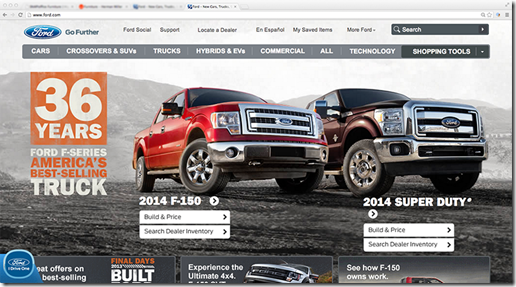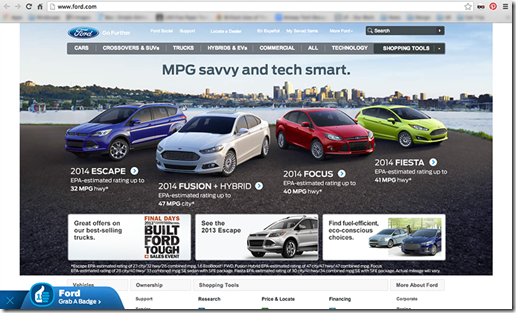During a meeting yesterday, I pulled up Ford.com to help illustrate a point I was attempting to make. While I was talking, Amy Snell pulled up the site as well, but didn’t see what I was showcasing. It wasn’t just different copy or a little detail, the entire design was different. This made me smile.
Here, you can see what Ford.com displayed for me…
And this is what Amy saw:
Easily Amused
I am very easily amused, so if you know me, it may not surprise you this made me happy.
While at the exact same URL (www.ford.com), we both get a unique user experience in alignment with our interests. Clearly, she received cars, I received trucks.
Intrigued, I asked Jeff to visit the site and he received cars as well (allowing me to tease him a little).
While I don’t know exactly what data they are mining, most likely internal to social to cookies, I do know I am a proud Ford truck owner. Assuming this was a good guess would be silly. Based on what Ford knows about me, they are serving me a user experience they feel best fits my intent on the site.
Using Data Must Add Value
Utilizing data that’s available or provided by your customers to give them the best overall user experience with your brand can pay dividends. It can generate big returns through more repeat traffic, more leads, higher sales, increased brand affinity, etc..
With a lot of upside, there’s also a fine line to walk. When developing your strategy on how to use the data you have or want to collect, always think of your customer first.
- Can the data be used to provide the customer with a better or more valuable user experience than if we didn’t know it?
- Can we answer questions for them based on what we know without requiring them to ask?
For example, anyone shopping for shoes wants to know if the shoes will fit. If we know their feet size and shape, and we have shoe size data, we can put the customer at the center of the user experience instead of the product by telling them the likelihood of the shoe fitting before digging into the marketing lingo about why they should buy the shoe that won’t fit them. We save them time, we save them money by ensuring they don’t purchase the wrong shoe they’ll need to return, and we showcase they are our priority.
In return, we get the best thing we can ask for: a trusting and loyal customer. That’s valuable all the way around.
What About Privacy?
The other fine line to walk is to ensure the customer doesn’t feel like you’ve invaded their privacy. If it doesn’t provide value to the user experience, don’t use it. Back to the Ford.com example, I know I own a Ford truck. It would be of no value to me if they had a banner on the homepage telling me which Ford truck I own and which may be good replacement options. Instead, they skip right to the replacement options, because by their estimations, that’s what I most likely care about and receive the most value from.
Creating a Customized Data-Driven User Experience
Things you need to take into consideration if you want create a customized user experience for your customers:
- Your target audience
- Current & prospective customers
- Your products/services
- Data you have
- Data you can easily collect
- Your goals/objective
If you need some ideas on how to make data collection an easy process, feel free to reach out to me. I’d be happy to talk with you about it.
I hope this helps!
Paul





